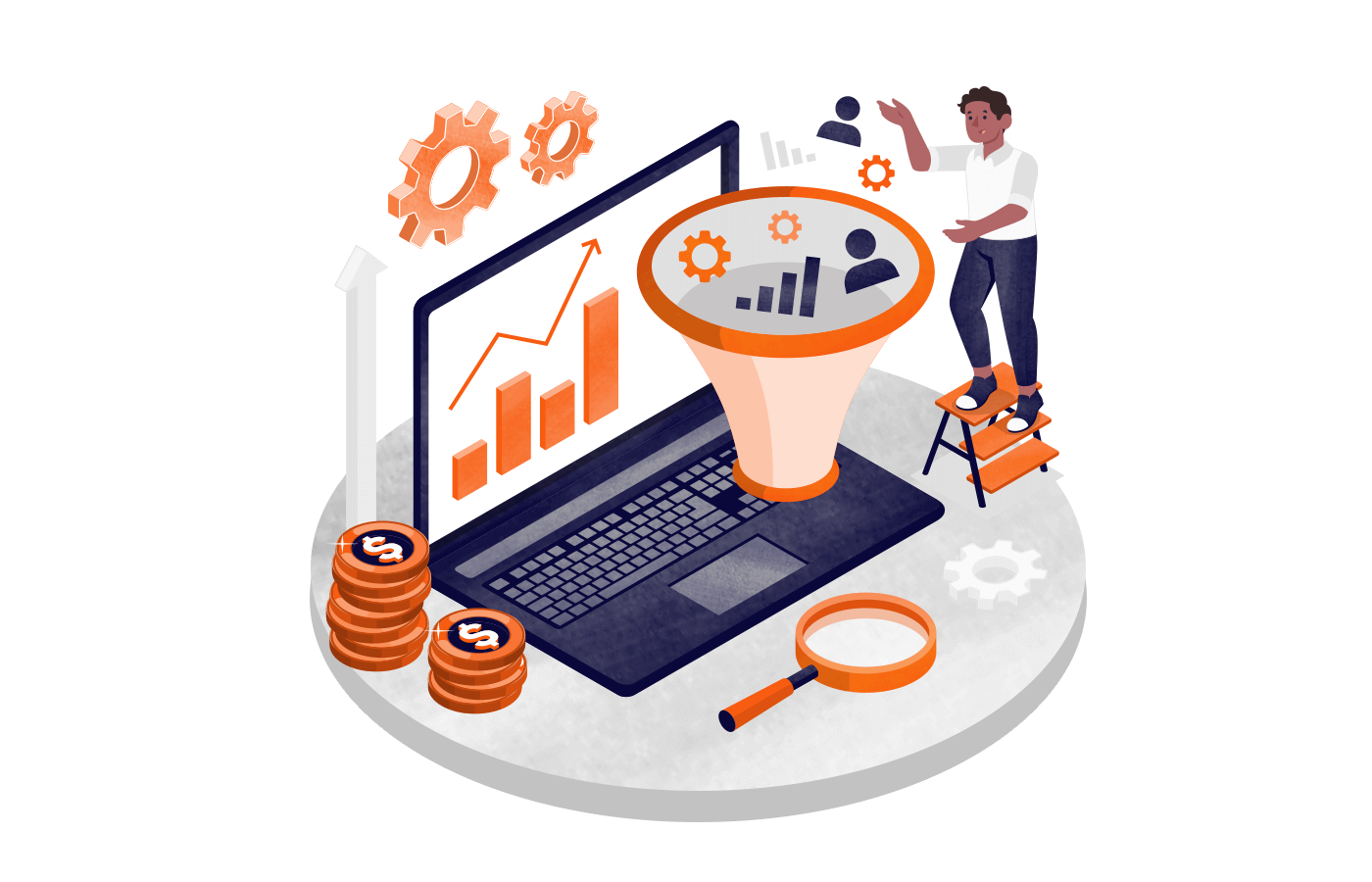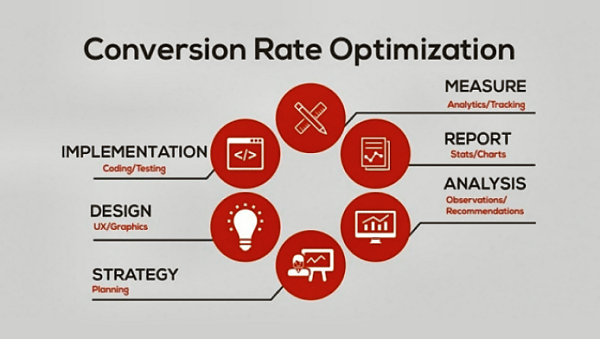The seven most fundamental elements of effective Conversion Rate Optimization (CRO) and web design are usability, clarity, user experience, content, layout, visuals, and technology. These seven elements are essential to creating a website that is successful in converting visitors into customers.
- Mobile Optimization: Ensure that your website is optimized for mobile devices, as mobile users account for a large portion of web traffic.
- User Experience: Make sure that your website is intuitive and easy to use, with a clear navigation structure and well-defined CTA’s.
- Content Strategy: Make sure that your content is targeted to the right audience and is optimized for SEO.
- Visual Design: Use visuals to create an attractive and engaging website.
- A/B Testing: Use A/B testing to optimize conversion rates.
- Conversion Rate Optimization: Use tools and techniques to analyze user behavior and optimize the website for maximum conversion rates.
- Analytics: Use analytics to measure the performance of your website and identify areas for improvement.
Usability is the foundation of effective web design, as it ensures that users can easily navigate the website and find what they need. Clarity and user experience provide the framework for the website, ensuring visitors understand the purpose of the website and how to interact with it.
Mobile Optimization
Mobile optimization is the process of ensuring that websites and other digital content can be easily accessed and navigated on a mobile device. This includes making sure the content displays correctly on different devices, optimizing page loading speeds, and ensuring the user experience is as smooth and seamless as possible.
- Develop a mobile-friendly version of your website
- Ensure that all text, images, videos, and animations display clearly on mobile devices
- Keep file sizes small to ensure pages load quickly
- Prioritize content so that the most important information is displayed first
- Use larger font sizes and buttons to make it easier to click on mobile devices
- Utilize responsive design to ensure that content displays properly on any device
- Test your mobile site on multiple devices and browsers
- Minimize the use of pop-ups and interstitials
- Implement Accelerated Mobile Pages (AMP) to speed up page load times
Mobile optimization is essential for businesses looking to increase their online visibility and provide a better user experience for their mobile customers. By optimizing for mobile, businesses can improve their organic search rankings, increase customer engagement and loyalty, and improve overall customer satisfaction.
User Experience
User experience (UX) is a term that is used to refer to the overall experience of a user when interacting with a website, app, product, or service. UX design is the process of creating a product, service, or experience that is easy to use and enjoyable, with the aim of making the user’s experience as efficient and pleasant as possible.
- User experience (UX) focuses on the user’s interactions with and perceptions of a product or service.
- UX design emphasizes the importance of creating an intuitive, enjoyable, and efficient experience for the user.
- UX design involves the design of interfaces, websites, mobile applications, and other products that users interact with.
- UX designers must analyze user behavior and use research methods to understand user needs and preferences.
- UX designers must have a deep understanding of the user’s goals and objectives in order to create effective designs.
- UX designers must be able to visualize how a product or service will be used and anticipate user needs.
- UX designers must be able to communicate effectively with developers, stakeholders, and other members of the design team.
Good UX design will ensure that users can easily find the information or features they need and that they can complete their tasks quickly and efficiently. Good UX design will also ensure that the user’s experience is engaging and intuitive, creating a positive experience that keeps them coming back.
Content Strategy
Content strategy is an important part of any business plan. It is the process of creating, managing, and delivering content that meets the needs of customers and other stakeholders. Content strategy takes into account the context and target audience of the content, as well as the desired outcomes of the content.
- Content strategy is the process of planning, creating, delivering, and managing content in order to meet business and user goals.
- Content strategy includes the development of a content plan, creation of content, and measurement of performance.
- Content should be created with an audience in mind and should be tailored to meet the needs of that audience.
- Content should be relevant and engaging, and should be optimized for search engines.
- Content should be distributed through appropriate channels in order to reach the desired audience.
- Content should be monitored and evaluated to ensure that it meets the goals set out in the content strategy.
It includes creating a content marketing plan, setting content goals, and creating a content calendar. Content strategy also includes developing content that is valuable, useful, and engaging, as well as creating content that is easily accessible and shareable. Content strategy is essential for creating an effective content marketing program that will engage customers, build loyalty, and help achieve business goals.
Visual Design
Visual Design is an important component of any design project, as it is the way that people interact with and experience a product. It involves the use of elements like color, shape, texture, and typography to create a visually appealing and functional design.
- Visual design should be unified, cohesive, and consistent.
- The elements of the design should be placed in a logical manner.
- Color, typography, and imagery should all be used to create a harmonious look.
- The design should be easily readable, understandable, and navigable.
- Visual design should be aesthetically pleasing and contribute to the overall message.
- Visual design should be tailored to the target audience.
Visual Designers focus on creating user experiences that are intuitive, attractive, and easy to use. Good Visual Design should also be consistent and versatile so that it can be used across multiple platforms and devices. Visual Designers must understand the psychology of aesthetics, as well as the principles of design, in order to create effective visuals.

A/B Testing
A/B testing is a method of experimentation used to compare two versions of a webpage, app, or other product in order to determine which one performs better. During an A/B test, two versions of a product are compared, often referred to as the A version and the B version.
- A/B testing is a type of experiment used to compare the effectiveness of two different versions of a product or service.
- It is also known as split testing, bucket testing, or split-run testing.
- A/B testing involves randomly assigning users to two different versions of a product or service to determine which one performs better.
- It is used to test changes to a website, mobile app, or other digital product to determine which one will produce better results.
- A/B testing is an important tool for improving user experience and driving conversions.
- A/B testing can be used to test changes to copy, design, layout, functionality, pricing, and more.
- The results of A/B testing can be used to make informed decisions about which version of a product or service should be used.
A/B testing is used to test the effectiveness of different variations of a product in order to determine which design or feature performs better. The results of an A/B test can be used to make decisions about which version of a product should be released. A/B testing is often used by companies to test the effectiveness of different designs, features, and content in order to improve the overall user experience.
Conversion Rate Optimization
Conversion rate optimization (CRO) is a process used to increase the percentage of visitors to a website that convert into customers, or more generally, take any desired action on a webpage. This process involves understanding customer behavior, testing hypotheses, and making changes to the website to increase conversions.
- Conversion rate optimization (CRO) is the process of increasing the percentage of website visitors who take a desired action (e.g. purchase a product, sign up for a newsletter, etc.).
- It involves understanding user behavior, testing different versions of the website, and making changes in order to improve the performance of the website.
- CRO is an ongoing process and requires continuous monitoring, testing, and tweaking in order to stay ahead of the competition.
- It involves understanding the customer journey, creating a user-friendly experience, and understanding the customer’s needs.
- A/B testing is a popular tool used to understand user behavior and test different versions of the website.
- Analyzing user data is also key to understanding user behavior and making informed decisions.
- Conversion rate optimization is an important part of any digital marketing strategy, as it can lead to increased conversions and improved ROI.
CRO can involve a range of strategies such as creating personalized experiences for customers, improving page load times, and increasing the visibility of calls to action. The goal of CRO is to improve customer satisfaction and increase the profitability of a business. CRO is a powerful tool to drive customer acquisition and increase ROI, and is essential for all businesses looking to maximize their online potential.
Analytics
Analytics is the systematic examination of data or statistics in order to gain insights and make better decisions. Analytics can be used in many different areas such as marketing, finance, and operations.
- Analytics is the systematic process of examining data or statistics in order to make decisions or draw conclusions.
- Analytics can be used to identify patterns, trends, and correlations in data.
- Analytics can be used to measure the effectiveness of a business’s marketing efforts, customer service efforts, and more.
- Analytics can be used to make predictions about future outcomes based on existing data.
- Analytics can help businesses understand their customers better.
- Analytics can help businesses identify areas of improvement and make informed decisions.
- Analytics can be used to optimize the efficiency of business operations.
- Analytics can be used to measure the success of products and services.
By using data to track customer behavior, website traffic, and other metrics, companies can gain insights into what works and what doesn’t. This helps them make better decisions and improve their operations. Analytics can also be used to identify opportunities and risks, predict future outcomes, and improve customer experiences. It is an essential tool for businesses to remain competitive and successful in today’s world.
